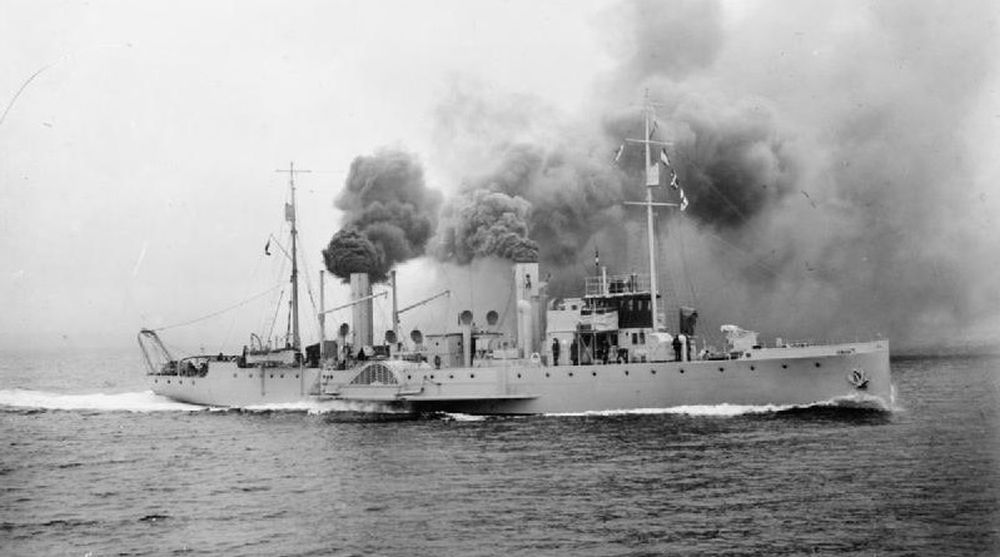paddlesteamers.info : The Internet's leading website for
Side-Wheeled Paddle Steamers
Purpose built paddle minesweepers for the Royal Navy in World War I
Paddle
steamers were particularly suited to coastal minesweeping duties due to
their relatively shallow draughts. The Royal Navy requisitioned many
such vessels from civilian operators during the war and also
during World War II. Two groups of paddle minesweepers were built
during World War I. A potential third group was ordered but
cancelled due to the end of hostilities.

Above
: Atherstone, which became Queen of Kent and later Lorna Doone, was one
of two navy minesweepers which went on to become passenger excursion
steamers after World War I.
Photo : Royal Navy and in the public domain
1st Group : 1916 : 24 vessels
Length : 254 ft 9 in. Breadth 29 ft (58 ft over paddleboxes)
Engines : Compound Diagonal, 26.5 and 52 in x 54 in, 1400 HP
Displacement Tons : 810
Speed : 15 knots
Armaments : 2 x 12 pound
Complement : 50-52
Ascot (Ailsa, Troon, engines by Dunsmuir & Jackson, Govan)
Atherstone (Ailsa, Troon, engines by Dunsmuir & Jackson, Govan)
Chelmsford (Ailsa, Troon, engines by Dunsmuir & Jackson, Govan)
Cheltenham (Ardrossan Dry Dock & Shipbuilding, Ardrossan,engines by Kincaid, Greenock)
Chepstow (Ayrshire Dockyard, Irvine, engines by Ross & Duncan, Glasgow)
Croxton (Ayrshire Dockyard, Irvine, engines by Dunsmuir & Jackson, Govan)
Doncaster (Ayrshire Dockyard, Irvine, engines by Dunsmuir & Jackson, Govan)
Eglinton (Ayrshire Dockyard, Irvine, engines by Dunsmuir & Jackson, Govan)
Epsom (George Brown & Co, Greenock, engines by McKie & Baxter, Govan)
Eridge (Clyde Shipbuilding & Engineering, Port Glasgow)
Gatwick (Dundee Shipbuilding Co, Dundee)
Goodwood (Dundee Shipbuilding Co, Dundee)
Haldon (Dunlop, Bremner & Co, Port Glasgow)
Hurst (Dunlop, Bremner & Co, Port Glasgow)
Kempton (Ferguson Bros, Port Glasgow)
Lingfield (Fleming & Ferguson, Paisley)
Ludlow (Goole Shipbuilding Co, Goole)
Melton (William Hamilton & Co, Port Glasgow, engines by Kincaid, Greenock)
Newbury (A&J Inglis, Glasgow)
Pontefract (Murdoch & Murray, Port Glasgow, engines by Dunsmuir & Jackson, Govan)
Plumpton (Archibald McMillan & Son, Dumbarton, engines by Rankin & Blackmore, Greenock)
Redcar (Ayrshire Dockyard, Irvine)
Sandown (Dunlop, Bremner & Co, Port Glasgow)
Totnes (Archibald McMillan & Son, Dumbarton, engines by Rankin & Blackmore, Greenock)
5 were lost on war service
Ascot - Lost 1918 by torpedo hit off the Farne Islands
Kempton - Lost 1917 by striking a mine off Calais
Ludlow - Lost 1916 by striking a mine off the Suffolk coast
Plumpton - Lost in 1918 by striking a mine off Ostend
Redcar - Lost in 1917 by striking a mine off Calais
The "Ascot" Class, also known as the "Racecourse" Class
Design by Ailsa of Troon
Most were sold in 1922/3. Chelmsford, Cheltenham and Chepstow were sold in1927
Two were sold to breakers but resold for conversion for passenger use in 1927 : Atherstone and Melton
2nd Group : 1918 : 8 vessels
Length : 249 ft 9 in. Breadth 29 ft (58 ft over paddleboxes)
Engines : Compound Diagonal, 1400 HP
Displacement Tons : 820
Speed : 15 knots
Armaments : 1 x 12 pound and 1 x 3 in anti-aircraft gun
Complement : 50-52
Banbury (Ailsa, Troon)
Harpenden (Ailsa, Troon)
Hexham (Clyde Shipbuilding & Engineering, Port Glasgow)
Lanark (Fleming & Ferguson, Paisley)
Lewes (Fleming & Ferguson, Paisley)
Shincliffe (Dundee Shipbuilding Co, Dundee)
Shirley (Dunlop, Bremner & Co, Port Glasgow)
Wetherby (Murdoch & Murray, Port Glasgow)
Shirley in 1919 with the others sold between 1922 and 1932
Return
to:
Homepage
Historical Database
